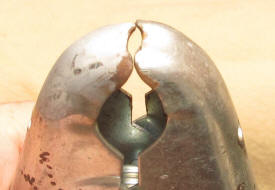|
|
Anderson Equipped Jumper Cables
 since 07/20/2013
since 07/20/2013
|
|
In the previous page I showed you how to connect
an Anderson connector to your truck's battery so that your inverter could be
portable. It follows that a very nice set of jumper cables can be made
at little additional cost that uses that same Anderson connector.
Having an Anderson connector on one end makes the cable somewhat
theft-resistant since it can't be used without the mating connector.
Of course, someone could lop off the Anderson connector and install two more
clamps but that requires actual work, not something thieves are known for. |
|
 |
Here are the finished cables. They're about 15 feet long and will
reach almost to the rear of the truck. Any longer and they'd be bulky
and heavy to handle. The cable is the same #2 gauge welding cable as used
on the battery connection. The clamps are NAPA "500 amp battery
clips". Probably available elsewhere but we only have a NAPA store in
the huge metropolis of Tellico :-) |
 |
The one weakness with these clamps is the cable attachment method. Not
very heavy for 500 amps, huh? That's #4 gauge cable connected to the
fitting. Since it's inadequate for the job, we're going to do it using a
better method. |
 |
We solder the #2 gauge cable right to the clamp. Even if the above
fitting had been adequate, the clamp is made of steel and so isn't very
electrically conductive. In its former role as the replacement
connector for a start pack, it would get quite warm during a normal jump
start. This configuration couples the electricity to within a fraction
of an inch of the battery terminal. |
|
 |
At the rear is a nice strain relief and cable holder. The easy way to
install the cable is to use a set of pliers to lift the spring and lay it on
the edge of the clamp. Then poke the cable through and snap the cable
back into position. |
|
 |
OK, here's where I got lazy. The photo shows what happens when you use
a small torch to do the soldering instead of the Roy induction heater.
I had Roy packed up in its traveling case and didn't want to get it out.
So I used a very small butane torch. Even though the torch was small, you
can see where the oxidizing flame oxidized the plating on the left jaw of
the clamp. |
 |
This shows how the burning flux smoked up the other jaw. It probably
won't hurt anything but it doesn't look professional. |






